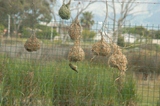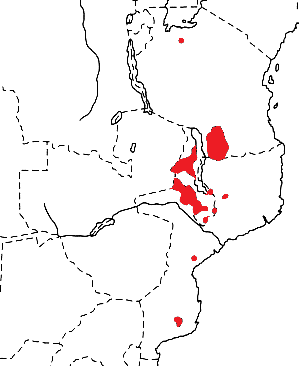Weaver species
Choose different species from drop-down list and press 'Go' button. See Full species list.Olive-headed Weaver Ploceus olivaceiceps
IUCN: Near threatened Discovery: 099Categories: nuthatch, IUCN, blue eggs,
News items about species
Discovery
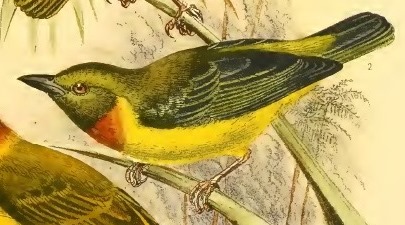
figure from Reichenow (1902) 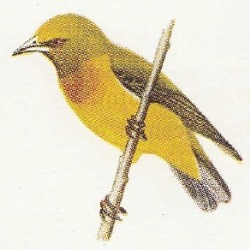
figure from Mackworth (1955) 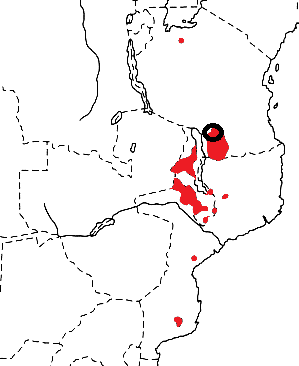
distribution, type locality circled IntroductionThe Olive-headed Weaver was formally described by Anton Reichenow, a German ornithologist and herpetologist.The Olive-headed Weaver was collected by Friedrich Fulleborn, a Prussian physician. Fulleborn studied medicine and natural sciences in Berlin. From 1896 onward, he was a military physician assigned to the Schutztruppe in German East Africa (Tanzania). In 1898-1900 he participated in the Nyassa- und Kingagebirgs Expedition to southern Tanzania, where he conducted anthropological and ethnographic research. He also collected bird specimens, which he sent to Berlin. He found the type of the Olive-headed Weaver near the source of the Rovuma River while near Songea. The first illustration of the Olive-headed Weaver was of an adult, published by Reichenow (1902). The next illustration was published much later by Mackworth (1955). Scientific citationSymplectes olivaceiceps Reichenow 1899a, Ornithol. Monatsber. 7:7, Songea, Tanzania.Meaning of namesolivaceiceps, Modern Latin: olivaceus, olivaceous; L. -ceps, headed.First English nameOlive-headed Golden Weaver (Shelley 1905b).Alternate namesOlive-headed Golden Weaver.CollectorFriedrich Fulleborn.Date collected1898.Locality collectedSongea, Tanzania.Type specimensThe type is in the Berlin Museum (ZMB_47.105). |
The above is based on Weaver Wednesday 2, a weekly series about the discovery of each weaver species.
This species text first appeared as
Weaver Wednesday [216] - Discovery [99]: Olive-headed Weaver on 2016-08-03
1. Basic biology
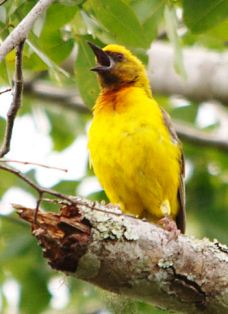
figure from wikipedia 
figure from PHOWN The female has a wholly olive head, and less chestnut on the breast. The juvenile is similar to the female but with a yellow chin and throat. The poorly-known Usambara Weaver is similar to this species, but their ranges do not overlap.
Distribution. The Olive-headed Weaver occurs in Tanzania, east Zambia, Malawi and Mombique (see map left, based on Birds of Africa). The northern-most record (from Mwamazengu, Tanzania) is from as recently as 1998. The southern Mozambique population has been described as a subspecies but the description was based on inadequate comparative specimens, and thus the species is treated as monotypic. The isolated population near Panda in southern Mozambique is separated by more than 600 km from any other known sites. There are about 100 pairs in the Panda area compared to a global population estimate of about 20000 pairs (1998). This species is near threatened, but the situation may worsen with increasing habitat loss. Habitat. The Olive-headed Weaver inhabits mature miombo (Brachystegia) woodland where Usnealichen is abundant. Food.
The Olive-headed Weaver feeds on insects, including butterflies and moths, beetles, bugs, and small wasps. It forages on tree trunks, clinging to the bark, and moving along the under and upper surfaces of branches, probing almost entirely in lichens. It is usually solitary or found in pairs, even when foraging in mixed bird parties.
Breeding. The Olive-headed Weaver is a monogamous, solitary nester, and the pair remains together all year. The nest is constructed entirely of Usnea, and is always placed in a thick clump of lichen, using living strands growing on a branch as a basis. The nest is placed on the underside of a thick branch rather than the tips of twigs. The nest is sited up to 18 m above the ground, generally near the crown of a tree. A short spout is usually added to the nest, but some nests lack a spout. Both male and female build the nest. Eggs are plain turquoise-blue or white. Incubation and feeding of chicks is by both sexes, but much more by the female in both cases. Bohm's Flycatchers may breed in old Olive-headed Weaver nests. |
The above is based on Weaver Wednesday, a weekly series about weaver species.
This species text first appeared as
Weaver Wednesday [53]: Olive-headed Weaver on 2013-06-19
2. Breeding facts
| Pair bond Monogamous, pair-members remaining together throughout year Breeding season Oct in Zambia, Sept-Oct in Malawi and Aug-Oct in Mozambique Nest site attached to branch being utilized as a base on underside of thick branches (not outer twigs), up to 18 m above ground and mostly near crown of tree Nest building built by both sexes Colony size Solitary nester Clutch size 2-3 eggs Egg colour plain turquoise-blue or white Egg size average size of three eggs 20 x 15 mm (Malawi) Incubation incubation by both sexes, but male only occasionally sitting, no information on duration of incubation period Chicks and nestling period chicks fed by both sexes, female contributing more than male, no information on duration of nestling period |
Breeding information based on Handbook of the Birds of the World, Vol. 15.
3. Photos of Weaver Nests
 Vm 30210 |  Vm 30209 |  Vm 14543 |  Vm 14542 |  Vm 13913 |  Vm 1989 |
Thumb-nails of most recent PHOWN records - click on one to see its full record
See all PHOWN records for this species here.
PHOWN (Photos of Weaver Nests) provides valuable info on breeding distribution and colony sizes of weavers.
You can contribute by registering and submitting photos at Virtual Museum webpage.
4. Breeding distribution
Google map showing distribution (For species with small ranges you need to zoom in at the correct area to see the range):
yellow blob - range of weaver species; read more about this here.
![]() - PHOWN records with photos
- PHOWN records with photos
![]() - PHOWN records with no photos (Nest Record Cards, other records)
- PHOWN records with no photos (Nest Record Cards, other records)
![]() - Birdpix records
- Birdpix records
![]() - comments on out of range records, or interesting records
- comments on out of range records, or interesting records
![]() - type locality
- type locality
CLICK on the marker on the map to see individual record details.
5. Range changes
Not South African speciesThe above is based on Weaver Wednesday 3, a weekly series about range changes in South African weaver species.
This species text first appeared as
n/a








